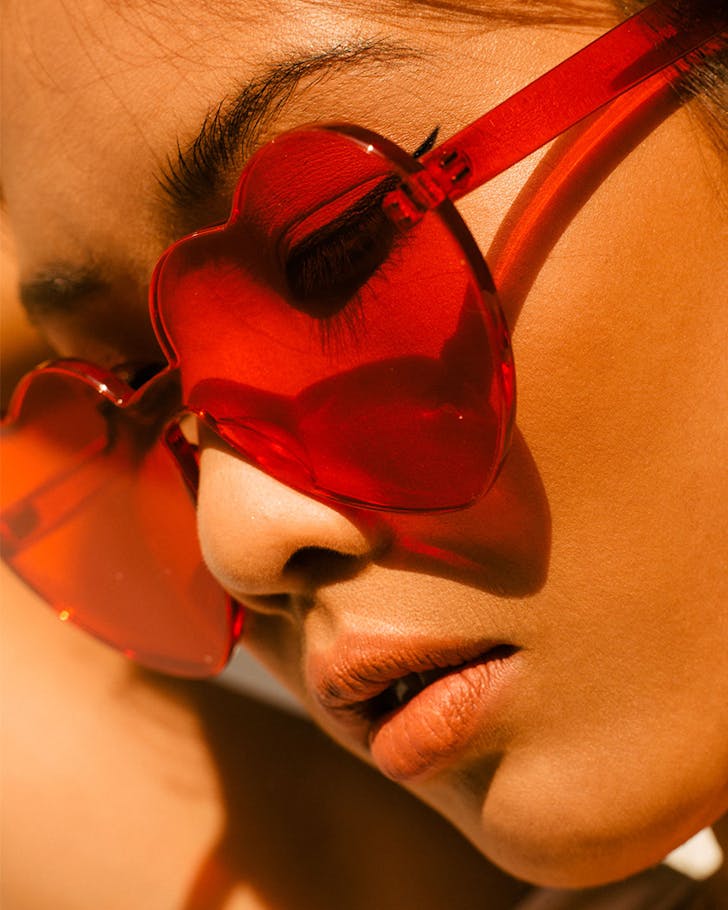Ditch The Exxy Face Creams, This Is The Only Anti-Ageing Method We Buy Into
We could start off spruiking alarming facts about skin cancer rates in Australia, but we all know it’s the most common cancer this side of the equator and, strangely, it doesn’t seem to sink in.
So instead, we’re going to approach it from another angle (albeit a much more vain angle) to get us all to sit up, pay attention and take action: the sun is largely responsible for premature ageing.
Yes, those little crow’s feet and smile lines are all thanks to our nearest star. The good news is they’re mostly preventable (especially if you’re under 30) all thanks to the magical product we know as sunscreen, remembering to apply it even when you don't think you're getting any exposure and knowing when to slip, slop, slap.
It's the only anti-ageing method we actually buy into, and it’s the reason we’re all upping our SPF and sun protection know how.
Let Us Break It Down For You
UVA Vs UVB—Please Explain?
We’ve all heard everyone harp on about UVAs and UVBs in recent years, but what actually are they? Simply put, UVA rays are responsible for damage to the skin’s dermis (it’s thickest layer) and can cause premature ageing, wrinkles and pigmentation, while UVB rays burn the topmost layers of the skin. Both UVA and UVB rays can lead to skin cancer.
UVA rays are present during all daylight hours and can penetrate clouds and glass, whereas UVB rays are strongest across the middle of the day (from around 8am to 4pm each day). So the moral of the story is: it's never a bad time to use sunscreen, and sunscreen with a broad spectrum that covers you for UVA and UVB rays will save you from the wrinkles AND the burn.
What’s The Deal With SPF?
If you’re new to this world of sun protection, SPF stands for 'sun protection factor', but what it really means is the amount of time it’ll take for your skin to burn compared to someone not wearing sunscreen at all. So something with an SPF of 30 will take 30 times longer for the skin to go pink. It doesn't mean you can sunscreen up and then stay outside all day though, no sunscreen blocks 100% of the UV.
Do I Go Chemical Or Physical?
Who knew sunscreen was so complicated? Physical sunscreens are made with a combination of titanium dioxide and zinc oxide and they form a barrier on the skin’s surface, preventing UV rays from penetrating the surface. Chemical sunscreens, on the other hand, absorb UVA and UVB rays, once again protecting skin from the damage they cause. The bottom line is, as long as there is an SPF label on the tube it's good sunscreen, so play around and find the type that works best for you.
What To Look For In A Sunscreen?
For maximum sun protection you’ll want to use sunscreen with an SPF between 30 and 50 that's water resistant. You also want something with broad spectrum on the label to ensure it will protect against UVA and UVB rays.
How Much Do I Use?
The general rule of thumb for adults is one teaspoon of sunscreen for the face and neck and a teaspoon per limb, chest and back. If you’re a perfectionist, we’ve found a handy sunscreen calculator to help you figure out how much to use based on what you’re wearing.
When Do I Apply And Reapply?
As we’ve mentioned, your skin can be affected by UVA rays anytime that the sun is up, so it’s best to apply your sunscreen 20 minutes before heading outside. It’s also time to load up your bag, car and desk with sunscreen, because you should be reapplying every two hours if you’re not in the shade. Check out MyUV to find out what UV index the sun is blasting out on any given day. It's important to remember that even if you're at a picnic under a shady tree, the weather is particularly cloudy or when you're going for a run (even for just 30 minutes), you will be exposed to harmful rays.
But It's Not All About Sunscreen
We don't want crepe neck to set in by our early 40s now, do we? So the other aspects of sun protection, like staying in the shade and wearing sun protective clothing, are equally important as wearing a good sunscreen. If you're going to be in the sun for longer periods of time at the beach or playing sports you'll want to look for long clothing with an ultraviolet protection factor to absorb those rays. And don't neglect your eyes. Throw on a hat with good coverage (ditch the baseball caps unless you want burnt ears) and some sunglasses which meet Australian standards for eye protection.

The Products We Swear By
Face
La Roche-Posay Anthelios XL Comfort Cream SPF 50+
Mecca To Save Face Superscreen 50+
Supergoop Unseen Sunscreen SPF 40
Neutrogena Ultra Sheer Clear Face Sunscreen SPF 30
Body
Neutrogena Ultra Sheer Body Mist Sunscreen SPF 50+
Cancer Council Everyday Sunscreen SPF 30+
Aēsop Protective Body Lotion SPF 50
Because we care, we’ve partnered up with Cancer Council to ensure your summer of fun in the sun stays that way. Click here for more SunSmart ways to protect your skin from harmful UV rays this summer.
Image credit: Sergey Filimonov and Nabi Tang
Editor's Note: This article was produced in partnership with SunSmart. To find out more about who we work with (and why!), read our editorial policy here.
